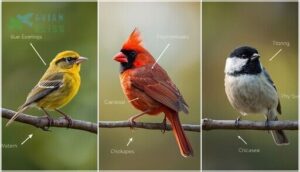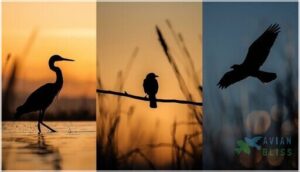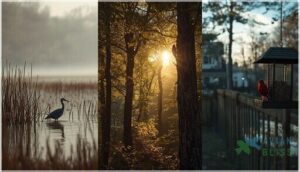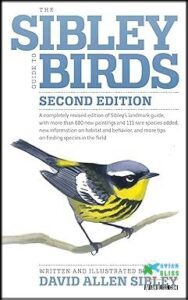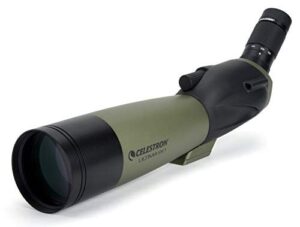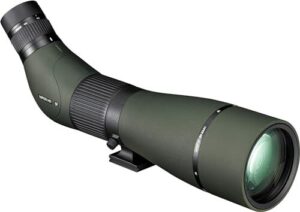This site is supported by our readers. We may earn a commission, at no cost to you, if you purchase through links.
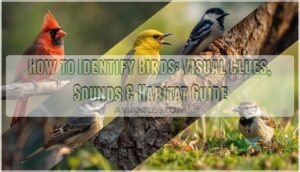
A flash of red darts across your backyard, and you’re left wondering what just flew past. You grab your phone to search “red bird,” but hundreds of results pop up. That’s the moment most people realize bird identification isn’t as simple as matching colors.
The trick lies in looking beyond just plumage. Bill shape tells you what a bird eats. Tail length reveals how it moves through its habitat. Even the way a bird hops versus walks can narrow down your options faster than flipping through a field guide.
Once you know what to look for, those mysterious visitors transform into recognizable species, turning every walk into a treasure hunt.
Table Of Contents
- Key Takeaways
- Visual Clues for Bird Identification
- Identifying Birds by Behavior and Movement
- Mastering Bird Sounds for Identification
- Using Habitat and Range to Narrow Down Species
- Top Tools and Guides for Bird Identification
- Frequently Asked Questions (FAQs)
- How do you identify a bird in a field?
- How do you identify birds in flight?
- How do I identify an unfamiliar bird?
- How do bird watchers identify birds?
- How do I find out what kind of bird this is?
- Is there a free app to identify birds?
- Can I upload a picture of a bird to identify it?
- How to learn to identify birds by sound?
- Can recording bird calls improve identification skills?
- How does seasonality affect bird identification?
- Conclusion
Key Takeaways
- Bird identification relies on multiple visual clues working together—bill shape reveals diet, tail structure shows flight style, and field marks like wing bars or eyerings separate similar species faster than color alone.
- Behavior patterns narrow down species as reliably as appearance, since feeding techniques, flight styles, and flock dynamics reflect specialized adaptations unique to each bird family.
- Sound identification opens up recognition when birds stay hidden, with songs used for mating and calls for daily communication—apps like Merlin and BirdNET now make learning these acoustic signatures accessible in the field.
- Habitat and range data eliminate unlikely species before you even raise binoculars, since ecosystems host predictable communities and migration patterns shift which birds appear seasonally in your region.
Visual Clues for Bird Identification
Identifying birds starts with what you can see. Your eyes are the most powerful tool you have, and knowing what to look for makes all the difference.
Let’s break down the key visual features that help you pin down a species.
Field Marks and Distinctive Features
Field marks—specific spots, stripes, and patches—are your key to identifying birds quickly. Focus on anatomical regions like the head, wings, and tail. Look for eyebrow stripes, wing bars, or eyerings that distinguish similar species. You’ll find these identifying characteristics documented in most field guides, but remember: lighting and distance can affect visibility.
With practice, you can reliably identify most regional species using these visual clues alone. Noticing a bird’s topographical regions can greatly assist in identification.
Plumage Patterns and Colors
Beyond individual field marks, you’ll want to study overall plumage patterns and colors—the identifying characteristics that define a species. Common patterns include mottled, barred, scaled, and spotted feathers. Black, white, gray, and brown dominate most bird plumage, while ornamental colors like blue and red often appear in small patches on males.
Plumage genetics and seasonal changes create the variations you’ll see throughout the year in avian identification. Birds can also exhibit unusual color patterns due to pigment abnormalities.
Body Shape and Proportions
Once you’ve noted plumage, shift your focus to body shape and proportions—key tools for silhouette identification in birdwatching. Learning to read a bird’s overall form helps you narrow down species quickly, even when colors aren’t visible. Pay attention to these proportional measurements:
- Leg length relative to body size separates ground-dwellers from tree climbers
- Wing length compared to tail length distinguishes aerial foragers
- Head size in relation to body aids identifying birds like raptors in flight
These functional correlations between shape and behavior make field application of avian identification more accurate across all bird species.
Bill Structure and Size
After evaluating overall form, turn your attention to the bill—one of your best tools for visual identification. Bill morphology reveals feeding adaptations instantly. Check bill length against head size and note the shape.
Bill structure influences song characteristics and reflects environmental impacts on bird species evolution, making it essential for developing strong bird identification skills.
| Bill Type | Example Species |
|---|---|
| Short, sturdy | Northern Cardinal |
| Long, slender | Nectarivores |
| Hooked | Red-tailed Hawk |
| Needle-like | Warblers |
| Bulbous | Grosbeaks |
Tail Shape and Length
Among flight mechanics indicators, tail structure deserves your close attention when building bird identification skills. Tail shape and feather length reveal aerodynamic adaptations and evolutionary pathways specific to each bird species.
- Forked tails indicate aerial hunters like swallows
- Rounded tails suit woodland maneuvering in thrushes
- Squared tails appear on flycatchers and jays
- Pointed tails mark diving specialists like terns
Most birds carry 12 tail feathers, though tail evolution produced striking variety across families.
Identifying Birds by Behavior and Movement
Birds aren’t just about what they look like—how they move tells you just as much. You can often pin down a species by watching what it does, from the way it hunts to how it flies.
Let’s break down the key behaviors that make identification easier.
Feeding Habits and Techniques
What a bird eats tells you who it is. You’ll notice hummingbirds hover at nectar sources while woodpeckers hammer bark for insects. Seed preferences vary—finches crack sunflower seeds, sparrows prefer millet.
Foraging strategies differ too: nuthatches climb headfirst down trunks, robins hop across lawns.
Supplemental feeding at feeders reveals dietary adaptations and aids conservation efforts, especially in winter when natural food sources decline.
Courtship Displays and Rituals
You’ll recognize bird species by their mate attraction behaviors during breeding season. Males perform ritual behaviors—from Northern Cardinals twisting their bodies to sage-grouse combining song and dance in complex displays.
Display complexity varies: some species offer food or fan feathers, while others focus on territory defense.
These courtship displays and songs help you identify species while revealing social bonding patterns critical for bird watching and understanding bird behavior.
Perching, Resting, and Flocking Behaviors
You can identify birds by watching how they perch, rest, and flock together. Perch preferences vary by species—some birds use higher branches while others stay low.
During rest, diurnal species sleep at night with heads tucked for warmth or alert for safety.
Flock dynamics reveal anti-predator strategies: synchronized perching creates group cohesion, with birds moving as one unit to detect threats and improve survival through bird watching and conservation efforts.
Flight Patterns and Silhouettes
Flight patterns and bird silhouettes offer powerful clues for bird identification during birdwatching. Hawks and raptors soar with outstretched wings, while woodpeckers show undulating flight styles with steep dips. Wing posture matters—Turkey Vultures hold a shallow ‘V’ shape, Eagles fly with flat, horizontal aerodynamic forms.
Hawks soar on flat wings, woodpeckers dip in waves, and vultures hold a telltale V—flight style reveals identity from a distance
These migration patterns and flight behaviors help you identify birds even at great distances, making silhouette recognition essential for spotting species reliably.
Mastering Bird Sounds for Identification
Bird sounds open up a whole new level of identification, especially when you can’t get a clear view. Once you learn to pick apart songs, calls, and subtle variations, you’ll recognize species long before you spot them.
Here’s what you need to know to train your ear and use the right tools.
Songs Vs. Calls: Key Differences
Understanding vocal complexity starts with one key distinction: bird songs attract mates and defend territories, while bird calls handle daily tasks like alarms and flock contact. Songs feature acoustic structure with melodic patterns, mostly from males during breeding season. Calls remain brief year-round sounds both sexes use.
Behavioral context differs too—songs advertise readiness, calls coordinate action. Species variations and seasonal patterns make sound ID easier once you grasp these fundamentals.
Pitch, Rhythm, and Tone Recognition
You can sharpen your sound ID by breaking bird songs into three acoustic elements: pitch (high or low frequency), rhythm isochrony (the spacing between notes), and tone (quality of the sound).
Spectral analysis tools and machine learning apps like BirdNET make these distinctions clearer.
App performance varies—Cornell’s birdsong identification app leads with strong accuracy for pitch, rhythm, and tone recognition in field testing.
Regional Dialects and Variations
When you recognize pitch and rhythm, you can pick up song divergence across regions. White-crowned Sparrows in coastal California sing different dialects just miles apart—this cultural transmission affects mate selection and bird identification. Urban dialects are expanding as city noise shapes bird sounds. Here’s what varies by region:
- Pitch and frequency shifts in urban populations
- Note spacing and timing patterns
- Phrase complexity and duration
- Tonal quality and emphasis
Understanding these differences has conservation implications for tracking isolated populations.
Using Apps and Tools for Bird Sounds
Once you’ve grasped regional song variations, bird sound identification apps can speed up your field work. Merlin Bird ID’s real-time ID feature runs offline functionality after you download regional sound libraries—it named all 10 species correctly in controlled tests. You’ll see multiple birds highlighted as they vocalize. BirdNET and ChirpOMatic expand app accuracy through citizen science contributions, helping you identify bird songs while building global databases that track population changes.
| App Feature | Merlin Bird ID | BirdNET |
|---|---|---|
| Real-time Display | Shows species as they sing | Processes recordings after capture |
| Offline Use | Works without cellular service | Requires internet connection |
| Species Coverage | Regional packs available | Over 6,000 global species |
Using Habitat and Range to Narrow Down Species
Where you spot a bird tells you as much as what it looks like. Different species stick to specific ecosystems, and knowing whether you’re in a forest, wetland, or backyard changes your identification game completely.
Let’s break down how habitat and range can help you narrow the field before you even raise your binoculars.
Common Birds in Different Ecosystems
Different habitats host unique avian species adapted to specific conditions. In forests, you’ll spot wood thrush and ovenbird among edge-sensitive species. Wetlands attract wading birds like herons and egrets with their long-leg adaptations. Grasslands support eastern meadowlarks and grasshopper sparrows, while deserts showcase cactus wrens and roadrunners. Urban areas are home to house sparrows and pigeons—each ecosystem’s bird community dynamics reflect specialized habitat bird adaptations essential for survival and conservation.
Seasonal Migration Patterns
You can identify seasonal bird migration patterns to narrow down species. Peak spring migration timing in the western United States hits late April and early May, while the Northeast peaks a few weeks later. Birds travel major flyway routes like the Pacific, Mississippi, and Atlantic corridors.
Spring migration speed averages 168 km per day—faster than autumn’s 76.7 km. Climate impacts increasingly reshape these avian species movements, affecting bird watching opportunities and economic impact on bird tourism.
Urban Vs. Rural Bird Populations
Where you live shapes what you’ll see. Urban areas host about 20% of global species, but you’ll notice 65–90% of city birds belong to just three to five common species—think House Sparrows and Robins.
Rural habitats offer greater species richness and diversity. Birdwatching apps help with species identification across both settings, though habitat loss and human impact continue reshaping bird populations and food availability everywhere.
Rare and Vagrant Species Identification
Spotting a vagrant species can spark excitement—but misidentification errors average 23.8%, especially for rare visitors. You’ll improve accuracy using eBird Reporting and Bird ID Help apps alongside a solid identification guide.
These tools draw on Citizen Science data, where sightings can boost local observer activity by 280%. Predictability Factors like storm patterns help anticipate arrivals.
Bird photo identification confirms finds, while understanding Economic Impact motivates conservation-focused birdwatching communities.
Utilizing Range Maps and Distribution Data
Range maps turn millions of Citizen Science observations into identification tools you can trust. They track Seasonal Distribution and Range Changes, boosting Identification Accuracy by showing where species actually occur.
Modern Bird identification apps integrate these maps with your location for real-time help:
- Color-coded breeding and migration zones
- Habitat Integration with satellite data
- Weekly population peaks by region
- 12% larger ranges for threatened species
- Real-time updates from Bird observations
Check maps before heading out Bird watching.
Top Tools and Guides for Bird Identification
You can’t identify birds with your eyes alone. The right tools make all the difference between a frustrating guessing game and a confident ID.
Here are six essential items that will sharpen your birding skills and help you spot details you’d otherwise miss.
1. Nikon Prostaff 3S 8×42 Binoculars
You’ll find the Nikon Prostaff 3S 8×42 binoculars deliver clear views when you’re tracking field marks and plumage patterns. Their optical performance shines with 8x magnification and multilayer-coated lenses, while the build quality withstands rough conditions—waterproof and fog-resistant for reliable bird watching.
The BaK-4 roof prisms and lens features produce sharp images, and the ergonomic design includes turn-and-slide eyecups that work well with glasses.
Consumer ratings consistently praise these binoculars for bird identification and bird photography, making them excellent value for your bird guide toolkit.
2. Sibley Guide to Birds Second Edition
You’ll need reliable Bird Identification Resources beyond optics, and the Sibley Guide to Birds Second Edition stands as the definitive Bird Guide for North American birders.
This field manual covers 930 species with over 7,000 Visual illustrations, digitally remastered for clarity. You get expanded Habitat information and voice descriptions for every entry, plus 600 new paintings including 115 rare species.
Taxonomic updates reflect current ornithological standards, while improved range maps sharpen your Bird ID accuracy.
Digital integration through the companion app aids field work with searchable Species coverage and export options to eBird for thorough Avian Identification.
3. Panasonic Lumix 4K Zoom Digital Camera
While field guides sharpen your identification skills, the Panasonic Lumix 4K Zoom Digital Camera transforms how you document birds in the field. Its 60x optical zoom and Camera Zoom Capabilities let you capture distant species without disturbing them, while Image Stabilization keeps shots crisp even at maximum magnification.
Video Recording at 4K resolution preserves behavioral details you might miss through binoculars. The lightweight build ensures excellent Field Use during long surveys, and Accessory Compatibility allows pairing with spotting scopes.
You’ll build a reliable photo reference library for Bird photography and Photo ID verification.
4. Celestron Ultima 80mm Angled Spotting Scope
For longer observation sessions where you need outstanding Optical Performance, the Celestron Ultima 80mm Angled Spotting Scope delivers excellent clarity with its 20-60x zoom range and 80mm objective lens. The 45-degree angled eyepiece reduces neck strain during extended bird watching sessions, while waterproof Build Quality withstands field conditions.
Its Digiscoping Adaptability allows you to capture Photo ID images through the integrated T-adapter, helping you Identify Birds in a Photo later.
At under $280, this scope offers considerable Market Value, and the comfortable User Experience aids your Bird identification techniques across varied habitats.
5. Sony Cyber Shot RX10 IV Camera
If you’re ready to capture photos alongside visual observation, the Sony Cyber Shot RX10 IV Camera combines a 24-600mm zoom lens with rapid Autofocus Performance, locking onto birds in flight at 24 frames per second.
The RX10 IV Specs include 315 phase-detection points covering 65% of the frame, delivering sharp Image Quality for Photo ID work. Its impressive Zoom Capabilities and Birding Suitability make it practical for Bird identification techniques without lens swaps.
At around $1,698, this all-in-one option refines your Bird watching tips through direct capture.
6. Vortex Viper HD Angled Spotting Scope
For sustained Bird ID sessions at fixed viewing stations, the Vortex Viper HD Angled Spotting Scope delivers reliable Optical Performance through its 20-60×85 mm HD lens and XR coatings.
Build Quality includes argon purging and ArmorTek protection, while User Functionality centers on helical focus and rotating collar adjustments.
Field Testing confirms sharp images in varied light, and Market Price near $900-$1,100 balances premium features with lifetime warranty coverage.
Consult an Online Bird Guide or Birdwatching Resources to pair this scope with Avian Identification Techniques for thorough Bird Guide Information.
Frequently Asked Questions (FAQs)
How do you identify a bird in a field?
Start with a quick assessment of the bird’s size, shape, and colors. Note the bill structure, tail length, and any distinctive field marks.
Practice benefits your observation skills, especially with confusing species.
How do you identify birds in flight?
Watch wingbeat patterns and flight silhouettes to identify raptors in flight. Notice feathers, tail shape, and soaring behavior.
Radar techniques and acoustic identification of bird calls help when visual clues aren’t enough.
How do I identify an unfamiliar bird?
When you spot an unfamiliar bird, note its size, colors, and bill shape first. Listen for bird calls or songs. Check field guides or apps like Merlin to match key characteristics and narrow down possibilities.
How do bird watchers identify birds?
Bird watchers use every tool imaginable to solve ID challenges—binoculars, bird watching apps for bird song identification, field guides, and citizen science platforms.
Expert tips emphasize ethical birding techniques for spotting common bird species and identifying raptors in flight.
How do I find out what kind of bird this is?
You’ll need to observe field marks, listen for songs or calls, note the habitat, and compare your findings.
Beginner mistakes often involve common lookalikes, so use Bird ID apps or guides for quick identification and accuracy.
Is there a free app to identify birds?
Yes. Merlin Bird ID and Audubon Bird Guide offer free species coverage with offline birding capabilities.
Both mobile apps provide accurate identification using photos, sounds, and a Bird ID wizard, though data privacy policies vary.
Can I upload a picture of a bird to identify it?
You can upload photos to apps like Merlin for AI identification. Image upload accuracy depends on photo quality impact and algorithm training data.
Mobile app species coverage exceeds 8,000 birds, though AI identification limitations exist for similar-looking species.
How to learn to identify birds by sound?
Want to tune your ear to bird songs? Start with common species, use Sound ID Apps like Merlin, study Regional Birdsongs at Macaulay Library, and practice Call Recognition to master Song Complexity through proven Training Methods.
Can recording bird calls improve identification skills?
Recording bird calls sharpens your identification skills through repeated listening. Audio ID accuracy improves when you build a call library and practice with apps like Merlin, though background noise and tech learning impact present method limitations.
How does seasonality affect bird identification?
Seasonal shifts act like nature’s costume changes—birds cycle through molt cycles, altering plumage variation and feathers. Migration patterns bring species through regions temporarily.
Songs, calls, and detectability bias fluctuate, complicating acoustic changes in identification accuracy.
Conclusion
Think of bird identification as learning a new language. At first, every chirp sounds the same and every brown bird blurs together. But once you train your eye to catch field marks, your ear to distinguish calls, and your mind to connect habitat with species, the code cracks open.
You’ll spot a Cedar Waxwing by its yellow tail tip before it even lands. That’s when birdwatching stops feeling like guesswork and starts feeling like fluency.
- https://openaccess.thecvf.com/content_cvpr_2014/papers/Berg_Birdsnap_Large-scale_Fine-grained_2014_CVPR_paper.pdf
- https://www.ntc.blm.gov/krc/system/files/legacy/uploads/3394/Statistical%20Guide%20to%20Data%20Analysis%20of%20Avian%20Monitoring%20Programs.pdf
- https://www.sciencedirect.com/science/article/pii/S1470160X24013438
- https://www.audubon.org/content/how-identify-birds
- https://onlinelibrary.wiley.com/doi/10.1155/vib/5292138

